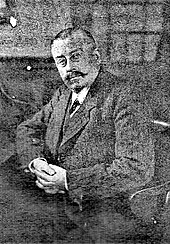Wilhelm Beth
Wilhelm Friedrich Ludwig Beth (* 1855 in Lübeck ; † August 27, 1922 there ) was a nationally known industrial pioneer .
Life
Beth's father was a mill builder and fitter at the Lübeck mill construction company Jaacks & Behrns . Wilhelm Beth also began his career as a mill builder and fitter. He used his savings to expand his knowledge in the building trade school in Holzminden , which he graduated as a civil engineer and mill builder.
Back in Lübeck, he first became a technical draftsman , then office manager at Jaacks & Behrns .
After his invention there in 1886, the aspiration of grinding technology, at the end of 1887 he founded his own business, the WFL Beth, Mühlenbauanstalt , which was later renamed WFL Beth Maschinenfabrik . A major dedusting industry developed from Beth's invention .
Wilhelm Beth designed bag filters , soon gave up building mills and turned entirely to the construction of filter apparatus . These were soon not only used in grain mills, but also in hard grinding such as in the cement industry .
He benefited from the fact that those promoting public health recognized that his filters could noticeably improve the air in the work rooms. In the fight against dust sickness , Beth's constructions received a special value.
In the early 1890s, Beth began building exhaustors of her own design. His filter systems found their way into almost all dust-generating branches of industry and the WTL Beth company became a global company whose products were known both inside and outside Europe.
Since the energetic founder had not accumulated sufficient assets in his work, his company was converted into a stock corporation in 1921 . As its general director, he continued his work.
He published his résumé in Mein Lebenslauf that same year.
Social concerns of the workforce
His attitude towards it at the time was remarkable. The Social Services was a personal concern Beth. This was evident to anyone who looked into the factory's workshops.
By 1910 there was no other company that showed a photographic insight into the washroom of its workers.
There were engineering offices and a large, bright drawing room. In addition to four commercial office rooms, there was a machine and boiler house, as well as an electrically operated test station for technical developments. Everything was up to date.
Patents
- 1886: # 38396, dust filter
- 1889: # 53553, ventilation systems in railroad cars
- 1906: US Patent 832,450 , Shaking Device For Tubular And like filter
- 1906: US Patent 833117 , Cleaning Filter Cloths In Dust-Collectors And The Like
- 1921: U.S. Patent 1389481 , Shaking Device For Cleaning Filters
- 1921: US_Patent 1389482 , Air or Gas Filter
- 1921: U.S. Patent 1390966 , Air Filter
- 1922: U.S. Patent 1433115 , Shaking Device For Cleaning Filters
swell
- From Lübeck's towers. Volume 32, No. 18, edition of September 9, 1922, article: General Director Wilhelm Beth †.
- Wilhelm Beth: My life. Lübeck 1921.
- Rüdiger Segenbusch: A turning point - factories in Lübeck. Lübeck 1993, ISBN 3-7950-0114-5 , chapter: Beth and Dräger - No factory without an idea
Web links
| personal data | |
|---|---|
| SURNAME | Beth, Wilhelm |
| ALTERNATIVE NAMES | Beth, Wilhelm Friedrich Ludwig |
| BRIEF DESCRIPTION | German businessman, entrepreneur and patron |
| DATE OF BIRTH | 1855 |
| PLACE OF BIRTH | Lübeck |
| DATE OF DEATH | August 27, 1922 |
| Place of death | Lübeck |


